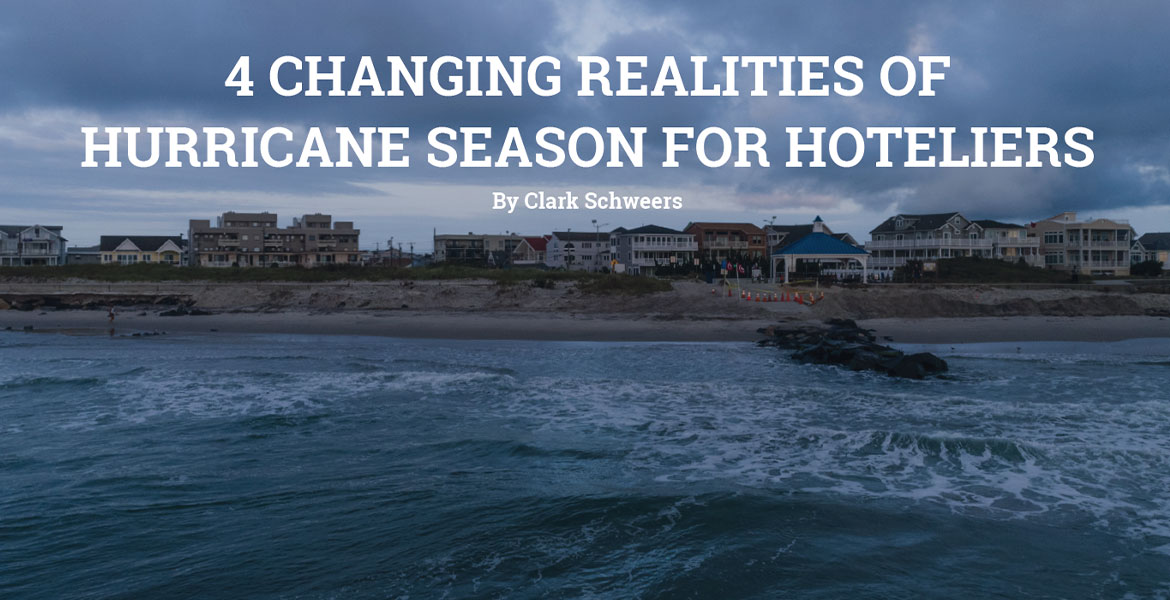Only a year has passed since the costliest hurricane season on record in the U.S. took thousands of lives and amounted in over US$306.2 billion in damages.
The hospitality industry was among the hardest hit from the year’s three most significant storms: Hurricanes Harvey, Irma and Maria. Hotels experienced—and many are still recovering from—physical property damage, business interruption losses and long-term impacts on occupancy rates.
Now, it’s déjà vu. Hurricane Florence—the first major hurricane of 2018—made landfall in the Carolinas in September. Hard-hit areas
accumulated over 30 inches of rainfall, and more than 1.4 million people experienced extended power outages. This month, Hurricane
Michael threatened the Florida Panhandle, hitting the coast as a Category 4 hurricane.
When a hurricane strike is looming, protecting the safety and well-being of guests is the hotel industry’s number one priority. While the core elements of an effective natural disaster response plan have not changed dramatically in the past year, hotels are encountering new and worsening risks and experiencing a shift in government response, prompting many to revisit their insurance policies and dedicate more resources to disaster response.
With more than a month left to hurricane season, hotel risk managers should consider four changing realities to better prepare for the remainder of the hurricane season:
1. The frequency and severity of extreme weather events are increasing—and top business leaders are taking an active role.
Hotels are facing natural disasters and dealing with the fallout on a more consistent basis. To adapt to this reality, risk managers are no longer the only stakeholders involved in developing disaster response plans. Corporate boards and C-Suite executives of multinational hotel companies are increasingly playing key roles in deciding how to mitigate property damage risks and business interruption losses.
2. Mandatory evacuation orders are becoming more common, but not all insurance policies offer full coverage for losses incurred during an evacuation.
Authorities are declaring states of emergency and issuing mandatory evacuation orders earlier than ever before, erring on the side of caution to protect human life. Hotels could be evacuated for several days, or even a week, prior to the storm making landfall. While there are avenues for hotels to recoup financial losses incurred during an evacuation, insurance policies are not always clear about the coverage provided.
Oftentimes, coverage begins the moment a hurricane makes landfall, which could leave hotels without grounds to recover financial losses in the days leading up to the storm. Protection and Preservation coverage allows for cost recovery for activities such as boarding up windows and sandbagging vulnerable areas, but the lost business associated with closing early may or may not be covered as part of this policy. Proactively discussing this issue with insurance carriers and brokers ca n help hotels reduce unwelcome surprises after an extreme weather event.
3. Recovery and financial losses don’t end the moment business resumes.
In the midst of a storm and in the immediate aftermath, a hotel’s first priorities are accounting for the safety of its guests, restoring power, repairing physical damage and resuming operations. But after the lights come on and all systems are up and running, the financial strain of a natural disaster is likely to persist.
Hotels are in the business of tourism, and occupancy rates rise and fall depending on the attractiveness of the destination. Some hotels are protected by loss of attraction insurance, which allows companies to make a financial claim if something that drives business to your asset has been impacted. If an airport, convention center, sporting events center or preeminent tourist attraction is under repair, hotels may recover lost revenue.
A severe weather event could decrease traffic to a location for a significant period of time. Travelers may be reluctant to visit an area still rebuilding from a natural disaster. Many hotels’ insurance policies include an extended period of indemnity provision, which accounts for the time it takes to regain guests and restore normal occupancy levels. After last year’s devastating hurricane season, hotels found that losses can go well in excess of the 60 days, or even 180 days, that most policies cover. In many cases, hoteliers are looking to extend their policies to cover one full year.
4. Storms that have lower category designations can still produce significant financial losses.
Many people—seasoned hotel executives included—breathed a sigh of relief recently when Hurricane Florence was downgraded from a category 4 to a category 1. What few people understand, however, is that wind speed is the only factor considered when a storm is categorized. Rainfall and flooding, the primary causes of storm-related deaths and damages, are not reflected in the hurricane’s category. Hotel executives should take precautions and consider all elements of a storm when preparing for disaster response.
With the first major storms of the year behind us, hotels are staring down the rest of hurricane season, which ends November 30. To meet the challenges ahead, hoteliers should take steps to clarify their insurance policies and refresh their natural disaster response plans.
This article was originally published in Hotels Magazine.
This article originally appeared in BDO USA, LLP’s “REC Monitor” newsletter (Winter 2019). Copyright © 2019 BDO USA, LLP. All rights reserved. www.bdo.com.


